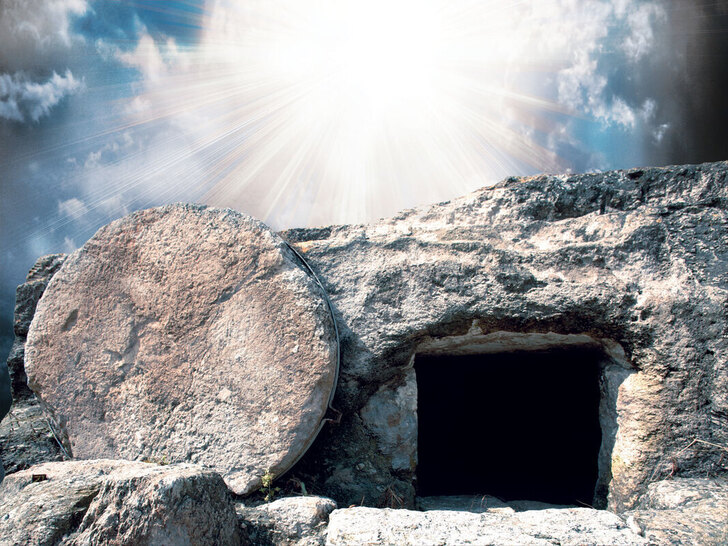Slow to Believe.
Slow to believe.
Even those closest to Jesus had trouble believing He was the Son of God. Jesus' entourage traveled with the Messiah; they ate with Him, lived with Him. They heard the sermons, saw His compassion, and His wisdom. His followers witnessed the miracles, the healings and watched in awe as Jesus raised the dead. Still, believing Jesus was the Son of God was a struggle. Then Jesus was crucified. Fearful and filled with doubt, His followers went into hiding. How could Jesus be God? How could He come back from the dead?
"They were not expecting it, although Jesus had repeatedly and plainly told them that he would rise on the third day (Matthew 16:21; 17:9; 17:23; 20:19; 26:32; 27:63; Mark 8:31; 9:31; Luke 18:33; 24:7). They must have taken his words to be a parable with some mysterious meaning. When the women went to the tomb it was, not to see if he had risen, but to prepare his body for permanent burial.
John alone, of all the disciples, believed at the sight of the empty tomb (John 20:8).
Mary Magdalene had only one thought, that some one had removed the body (John 20:13; 20:15).
The report of the women that Jesus had risen appeared to the disciples as "idle talk" (Luke 24:11).
When the two from Emmaus told the eleven that Jesus had appeared to them, "neither believed they them" (Mark 16:13).
Peter reported that Jesus had appeared to him (Luke 24:34). But still they believed not (Mark 16:14).
Thus, Jesus had repeatedly foretold it. Angels announced it. The tomb was empty. His body was gone. Mary Magdalene had seen him. The other women had seen him. Cleopas and his companion had seen him. Peter had seen him. Still the group as a whole did not believe. It just seemed to them incredible.
Then, when Jesus appeared to the ten that night he upbraided them for their hard-hearted unwillingness to believe those that had seen him (Mark 16:14). Still they thought he was only a ghost, and he invited them to look closely at his hands, side and feet, and to "handle" him. Then he asked for food, and "did eat before them" (Luke 24:38-43; John 20:20).
After all that , Thomas, gloomy, doubting Thomas, was sure that there was a mistake somewhere, and did not believe till he personally saw Jesus a week later (John 20:24-29).
Thus, those who first proclaimed the story of Jesus' resurrection were themselves totally unprepared to believe it, determined not to believe it, and came to believe it in spite of themselves. This renders untenable any possibility that the story was born of an excited and expectant imagination. There is no conceivable way to account for the origin of the story except that it was an actual fact. We, too, one day, by his grace, shall rise."
(From "Halley's Bible Handbook" by Henry H. Halley, Zondervan Publishing House, Grand Rapids, Michigan; page 554)
Even those closest to Jesus had trouble believing He was the Son of God. Jesus' entourage traveled with the Messiah; they ate with Him, lived with Him. They heard the sermons, saw His compassion, and His wisdom. His followers witnessed the miracles, the healings and watched in awe as Jesus raised the dead. Still, believing Jesus was the Son of God was a struggle. Then Jesus was crucified. Fearful and filled with doubt, His followers went into hiding. How could Jesus be God? How could He come back from the dead?
"They were not expecting it, although Jesus had repeatedly and plainly told them that he would rise on the third day (Matthew 16:21; 17:9; 17:23; 20:19; 26:32; 27:63; Mark 8:31; 9:31; Luke 18:33; 24:7). They must have taken his words to be a parable with some mysterious meaning. When the women went to the tomb it was, not to see if he had risen, but to prepare his body for permanent burial.
John alone, of all the disciples, believed at the sight of the empty tomb (John 20:8).
Mary Magdalene had only one thought, that some one had removed the body (John 20:13; 20:15).
The report of the women that Jesus had risen appeared to the disciples as "idle talk" (Luke 24:11).
When the two from Emmaus told the eleven that Jesus had appeared to them, "neither believed they them" (Mark 16:13).
Peter reported that Jesus had appeared to him (Luke 24:34). But still they believed not (Mark 16:14).
Thus, Jesus had repeatedly foretold it. Angels announced it. The tomb was empty. His body was gone. Mary Magdalene had seen him. The other women had seen him. Cleopas and his companion had seen him. Peter had seen him. Still the group as a whole did not believe. It just seemed to them incredible.
Then, when Jesus appeared to the ten that night he upbraided them for their hard-hearted unwillingness to believe those that had seen him (Mark 16:14). Still they thought he was only a ghost, and he invited them to look closely at his hands, side and feet, and to "handle" him. Then he asked for food, and "did eat before them" (Luke 24:38-43; John 20:20).
After all that , Thomas, gloomy, doubting Thomas, was sure that there was a mistake somewhere, and did not believe till he personally saw Jesus a week later (John 20:24-29).
Thus, those who first proclaimed the story of Jesus' resurrection were themselves totally unprepared to believe it, determined not to believe it, and came to believe it in spite of themselves. This renders untenable any possibility that the story was born of an excited and expectant imagination. There is no conceivable way to account for the origin of the story except that it was an actual fact. We, too, one day, by his grace, shall rise."
(From "Halley's Bible Handbook" by Henry H. Halley, Zondervan Publishing House, Grand Rapids, Michigan; page 554)

